翻译基本概念2
- 格式:ppt
- 大小:207.50 KB
- 文档页数:57
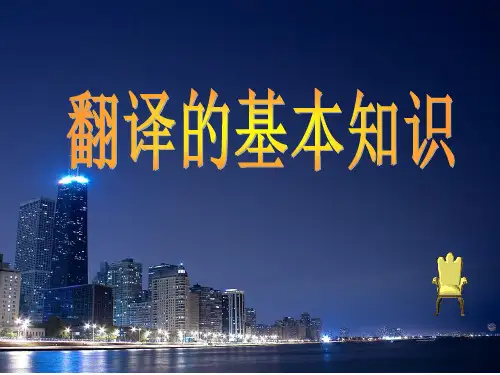
一、翻译的定义什么时候有了一个民族或部落同另一个民族或部落的接触,什么时候就有了翻译。
西方自一世纪、中国自商周时期开始就有了跨语言翻译(inter-lingual translation)。
唐代贾公彦在《义疏》中写道:“译即易,谓换易言语使相解也。
”《辞源》对翻译的解释是:“用一种语言表达他种语文的意思。
”《大英百科全书》:“将用一种语言或者一套语言符号所表示的内容用另一种语言或者一套语言符号进行转换的行为或者过程。
”对于翻译较为完整的定义,要数现代翻译家奈达的:Translation consists in producing in the receptor language the closestnatural equivalent of the source language message, first in terms of meaning and secondly in terms of style.即所谓翻译,是指从语义到文体上在译语中用最切近而且最自然的对等语再现原语的信息,首先在语义上,其次在文体上。
人物简介贾公彦-贾公彦(生卒年不详,活动期公元7世纪中叶)中国唐代学者。
铭州永年(今河北永年县)人,唐高宗永徽元年(650年)发现指纹的特征及用途。
他官至太学博士。
撰《周礼义疏》50卷、《仪礼义疏》40卷。
指纹是手指远端掌面的凹凸花纹。
由长短、形状、粗细、结构不同的纹线组成,分弓、箕、斗三种基本类型,具有终生不变、各不相同的特点。
因此,指纹被广泛用作侦破案件、人身保险、研究遗传疾病和人的自然素质的依据,成为法医学和遗传学等学科的重要研究课题。
据德国R·海因德尔撰写的《指纹鉴定》(1927年)一书中指出:“世界上第一个用作鉴定的指纹的著作者是中国唐朝的贾公彦,他是唐代的著作家。
他的作品大约写于公元650年,他是着重指出指纹是确认个人的方法的第一人”。
贾公彦,其字不详,唐州永年(今河北邯郸市东北)人。
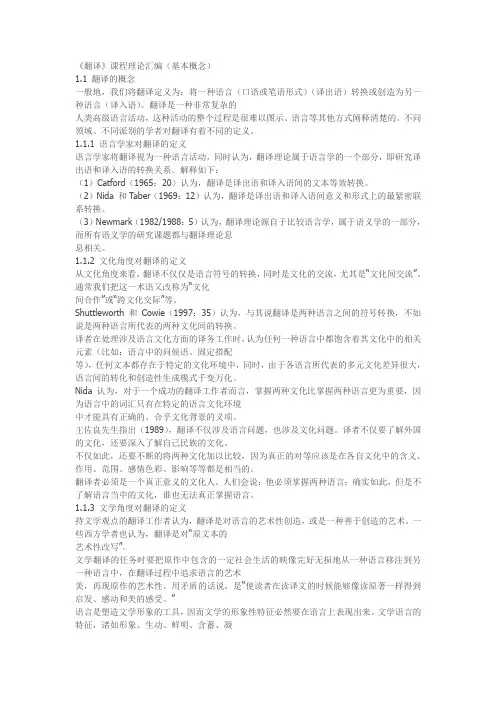
《翻译》课程理论汇编(基本概念)1.1 翻译的概念一般地,我们将翻译定义为:将一种语言(口语或笔语形式)(译出语)转换或创造为另一种语言(译入语)。
翻译是一种非常复杂的人类高级语言活动,这种活动的整个过程是很难以图示、语言等其他方式阐释清楚的。
不同领域、不同派别的学者对翻译有着不同的定义。
1.1.1 语言学家对翻译的定义语言学家将翻译视为一种语言活动,同时认为,翻译理论属于语言学的一个部分,即研究译出语和译入语的转换关系。
解释如下:(1)Catford(1965:20)认为,翻译是译出语和译入语间的文本等效转换。
(2)Nida 和Taber(1969:12)认为,翻译是译出语和译入语间意义和形式上的最紧密联系转换。
(3)Newmark(1982/1988:5)认为,翻译理论源自于比较语言学,属于语义学的一部分,而所有语义学的研究课题都与翻译理论息息相关。
1.1.2 文化角度对翻译的定义从文化角度来看,翻译不仅仅是语言符号的转换,同时是文化的交流,尤其是“文化间交流”。
通常我们把这一术语又改称为“文化间合作”或“跨文化交际”等。
Shuttleworth 和Cowie(1997:35)认为,与其说翻译是两种语言之间的符号转换,不如说是两种语言所代表的两种文化间的转换。
译者在处理涉及语言文化方面的译务工作时,认为任何一种语言中都饱含着其文化中的相关元素(比如:语言中的问候语、固定搭配等),任何文本都存在于特定的文化环境中,同时,由于各语言所代表的多元文化差异很大,语言间的转化和创造性生成模式千变万化。
Nida 认为,对于一个成功的翻译工作者而言,掌握两种文化比掌握两种语言更为重要,因为语言中的词汇只有在特定的语言文化环境中才能具有正确的、合乎文化背景的义项。
王佐良先生指出(1989),翻译不仅涉及语言问题,也涉及文化问题。
译者不仅要了解外国的文化,还要深入了解自己民族的文化。
不仅如此,还要不断的将两种文化加以比较,因为真正的对等应该是在各自文化中的含义、作用、范围、感情色彩、影响等等都是相当的。
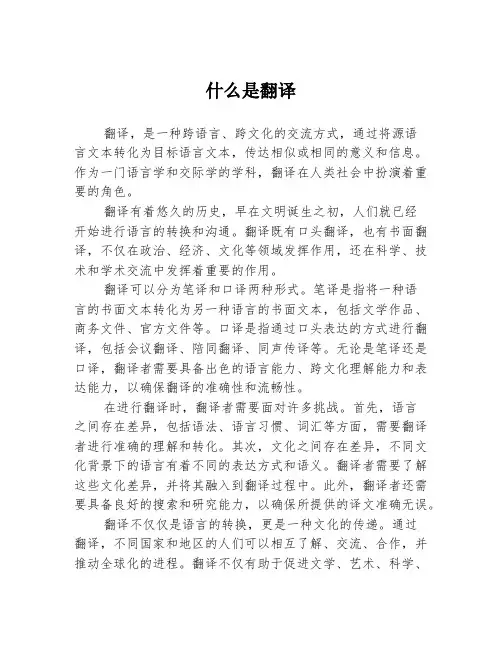
什么是翻译翻译,是一种跨语言、跨文化的交流方式,通过将源语言文本转化为目标语言文本,传达相似或相同的意义和信息。
作为一门语言学和交际学的学科,翻译在人类社会中扮演着重要的角色。
翻译有着悠久的历史,早在文明诞生之初,人们就已经开始进行语言的转换和沟通。
翻译既有口头翻译,也有书面翻译,不仅在政治、经济、文化等领域发挥作用,还在科学、技术和学术交流中发挥着重要的作用。
翻译可以分为笔译和口译两种形式。
笔译是指将一种语言的书面文本转化为另一种语言的书面文本,包括文学作品、商务文件、官方文件等。
口译是指通过口头表达的方式进行翻译,包括会议翻译、陪同翻译、同声传译等。
无论是笔译还是口译,翻译者需要具备出色的语言能力、跨文化理解能力和表达能力,以确保翻译的准确性和流畅性。
在进行翻译时,翻译者需要面对许多挑战。
首先,语言之间存在差异,包括语法、语言习惯、词汇等方面,需要翻译者进行准确的理解和转化。
其次,文化之间存在差异,不同文化背景下的语言有着不同的表达方式和语义。
翻译者需要了解这些文化差异,并将其融入到翻译过程中。
此外,翻译者还需要具备良好的搜索和研究能力,以确保所提供的译文准确无误。
翻译不仅仅是语言的转换,更是一种文化的传递。
通过翻译,不同国家和地区的人们可以相互了解、交流、合作,并推动全球化的进程。
翻译不仅有助于促进文学、艺术、科学、技术等领域的交流与发展,同时也有助于缩小各种差距,促进世界和平与发展。
总之,翻译作为一门重要的语言学和交际学学科,不仅在日常生活中发挥着重要作用,也在全球化的背景下具有重要意义。
通过翻译,人们可以跨越语言和文化的障碍,实现跨国交流与合作,共同推动人类社会的发展。
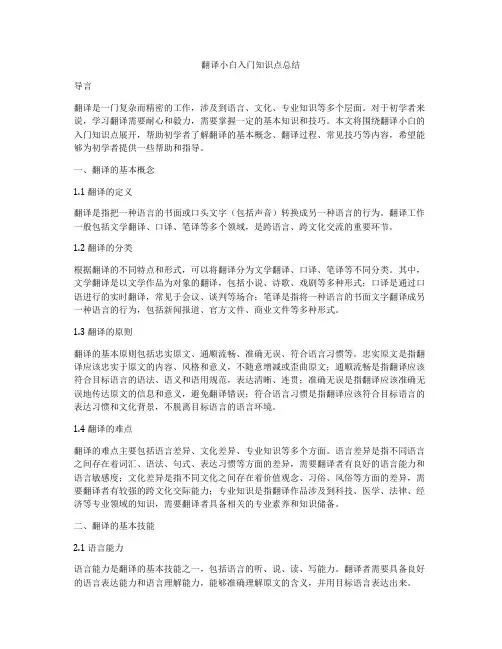
翻译小白入门知识点总结导言翻译是一门复杂而精密的工作,涉及到语言、文化、专业知识等多个层面。
对于初学者来说,学习翻译需要耐心和毅力,需要掌握一定的基本知识和技巧。
本文将围绕翻译小白的入门知识点展开,帮助初学者了解翻译的基本概念、翻译过程、常见技巧等内容,希望能够为初学者提供一些帮助和指导。
一、翻译的基本概念1.1 翻译的定义翻译是指把一种语言的书面或口头文字(包括声音)转换成另一种语言的行为。
翻译工作一般包括文学翻译、口译、笔译等多个领域,是跨语言、跨文化交流的重要环节。
1.2 翻译的分类根据翻译的不同特点和形式,可以将翻译分为文学翻译、口译、笔译等不同分类。
其中,文学翻译是以文学作品为对象的翻译,包括小说、诗歌、戏剧等多种形式;口译是通过口语进行的实时翻译,常见于会议、谈判等场合;笔译是指将一种语言的书面文字翻译成另一种语言的行为,包括新闻报道、官方文件、商业文件等多种形式。
1.3 翻译的原则翻译的基本原则包括忠实原文、通顺流畅、准确无误、符合语言习惯等。
忠实原文是指翻译应该忠实于原文的内容、风格和意义,不随意增减或歪曲原文;通顺流畅是指翻译应该符合目标语言的语法、语义和语用规范,表达清晰、连贯;准确无误是指翻译应该准确无误地传达原文的信息和意义,避免翻译错误;符合语言习惯是指翻译应该符合目标语言的表达习惯和文化背景,不脱离目标语言的语言环境。
1.4 翻译的难点翻译的难点主要包括语言差异、文化差异、专业知识等多个方面。
语言差异是指不同语言之间存在着词汇、语法、句式、表达习惯等方面的差异,需要翻译者有良好的语言能力和语言敏感度;文化差异是指不同文化之间存在着价值观念、习俗、风俗等方面的差异,需要翻译者有较强的跨文化交际能力;专业知识是指翻译作品涉及到科技、医学、法律、经济等专业领域的知识,需要翻译者具备相关的专业素养和知识储备。
二、翻译的基本技能2.1 语言能力语言能力是翻译的基本技能之一,包括语言的听、说、读、写能力。
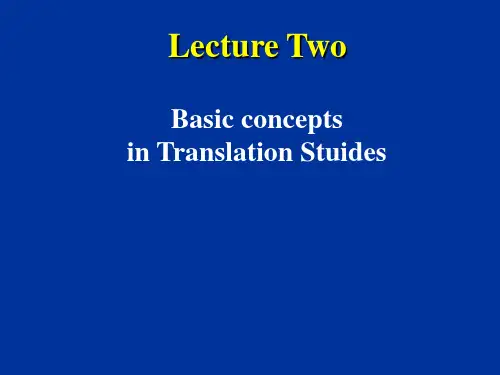
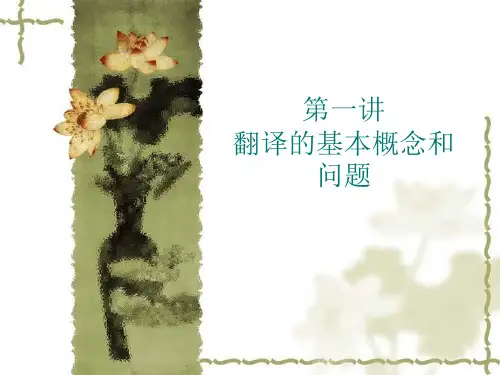
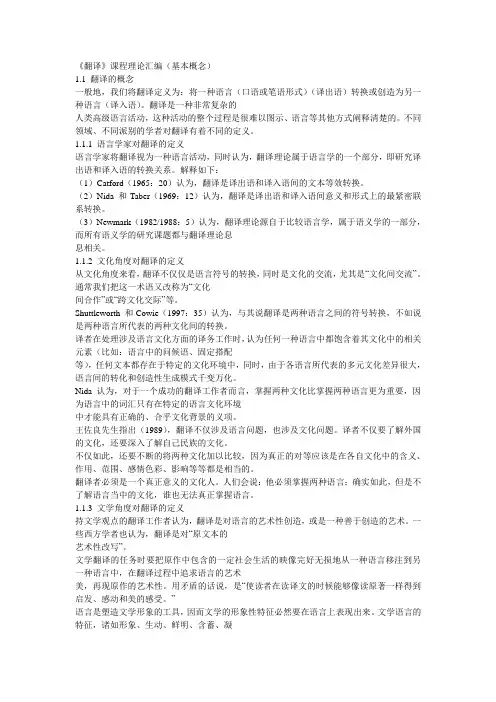
《翻译》课程理论汇编(基本概念)1.1 翻译的概念一般地,我们将翻译定义为:将一种语言(口语或笔语形式)(译出语)转换或创造为另一种语言(译入语)。
翻译是一种非常复杂的人类高级语言活动,这种活动的整个过程是很难以图示、语言等其他方式阐释清楚的。
不同领域、不同派别的学者对翻译有着不同的定义。
1.1.1 语言学家对翻译的定义语言学家将翻译视为一种语言活动,同时认为,翻译理论属于语言学的一个部分,即研究译出语和译入语的转换关系。
解释如下:(1)Catford(1965:20)认为,翻译是译出语和译入语间的文本等效转换。
(2)Nida 和Taber(1969:12)认为,翻译是译出语和译入语间意义和形式上的最紧密联系转换。
(3)Newmark(1982/1988:5)认为,翻译理论源自于比较语言学,属于语义学的一部分,而所有语义学的研究课题都与翻译理论息息相关。
1.1.2 文化角度对翻译的定义从文化角度来看,翻译不仅仅是语言符号的转换,同时是文化的交流,尤其是“文化间交流”。
通常我们把这一术语又改称为“文化间合作”或“跨文化交际”等。
Shuttleworth 和Cowie(1997:35)认为,与其说翻译是两种语言之间的符号转换,不如说是两种语言所代表的两种文化间的转换。
译者在处理涉及语言文化方面的译务工作时,认为任何一种语言中都饱含着其文化中的相关元素(比如:语言中的问候语、固定搭配等),任何文本都存在于特定的文化环境中,同时,由于各语言所代表的多元文化差异很大,语言间的转化和创造性生成模式千变万化。
Nida 认为,对于一个成功的翻译工作者而言,掌握两种文化比掌握两种语言更为重要,因为语言中的词汇只有在特定的语言文化环境中才能具有正确的、合乎文化背景的义项。
王佐良先生指出(1989),翻译不仅涉及语言问题,也涉及文化问题。
译者不仅要了解外国的文化,还要深入了解自己民族的文化。
不仅如此,还要不断的将两种文化加以比较,因为真正的对等应该是在各自文化中的含义、作用、范围、感情色彩、影响等等都是相当的。
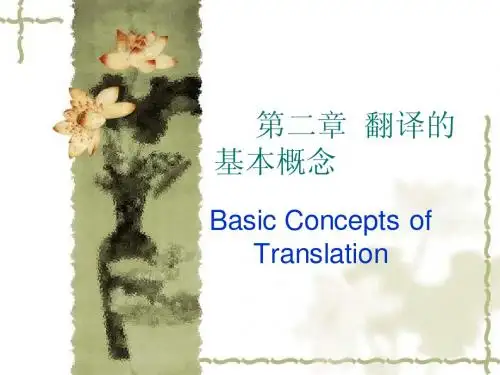
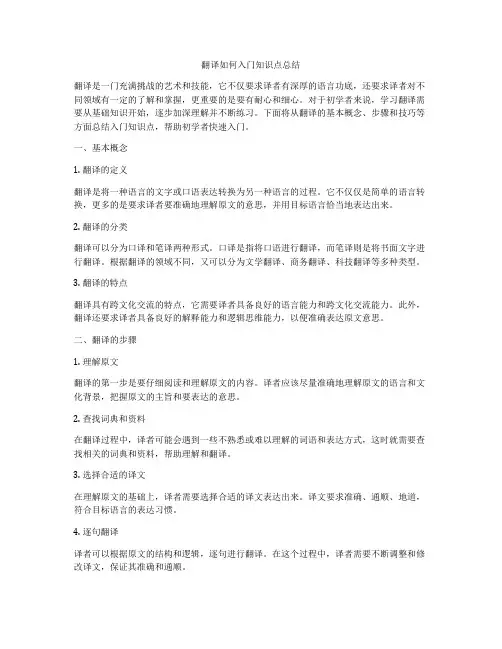
翻译如何入门知识点总结翻译是一门充满挑战的艺术和技能,它不仅要求译者有深厚的语言功底,还要求译者对不同领域有一定的了解和掌握,更重要的是要有耐心和细心。
对于初学者来说,学习翻译需要从基础知识开始,逐步加深理解并不断练习。
下面将从翻译的基本概念、步骤和技巧等方面总结入门知识点,帮助初学者快速入门。
一、基本概念1. 翻译的定义翻译是将一种语言的文字或口语表达转换为另一种语言的过程。
它不仅仅是简单的语言转换,更多的是要求译者要准确地理解原文的意思,并用目标语言恰当地表达出来。
2. 翻译的分类翻译可以分为口译和笔译两种形式。
口译是指将口语进行翻译,而笔译则是将书面文字进行翻译。
根据翻译的领域不同,又可以分为文学翻译、商务翻译、科技翻译等多种类型。
3. 翻译的特点翻译具有跨文化交流的特点,它需要译者具备良好的语言能力和跨文化交流能力。
此外,翻译还要求译者具备良好的解释能力和逻辑思维能力,以便准确表达原文意思。
二、翻译的步骤1. 理解原文翻译的第一步是要仔细阅读和理解原文的内容。
译者应该尽量准确地理解原文的语言和文化背景,把握原文的主旨和要表达的意思。
2. 查找词典和资料在翻译过程中,译者可能会遇到一些不熟悉或难以理解的词语和表达方式,这时就需要查找相关的词典和资料,帮助理解和翻译。
3. 选择合适的译文在理解原文的基础上,译者需要选择合适的译文表达出来。
译文要求准确、通顺、地道,符合目标语言的表达习惯。
4. 逐句翻译译者可以根据原文的结构和逻辑,逐句进行翻译。
在这个过程中,译者需要不断调整和修改译文,保证其准确和通顺。
5. 校对和修改翻译完成后,译者需要进行校对和修改。
通过反复比对原文和译文,检查是否有疏漏和错误,保证译文的准确性和通顺性。
三、翻译的技巧1. 保持灵活翻译过程中,译者需要保持灵活的思维和表达方式。
有时候原文的表达方式可能与目标语言有所差异,译者需要灵活运用语言,使译文更为贴切和地道。
2. 注意语言的风格不同的文体和不同的领域有不同的语言风格,在翻译过程中,译者需要注意语言的风格和用词习惯,力求表达出与原文相同的语言特点。
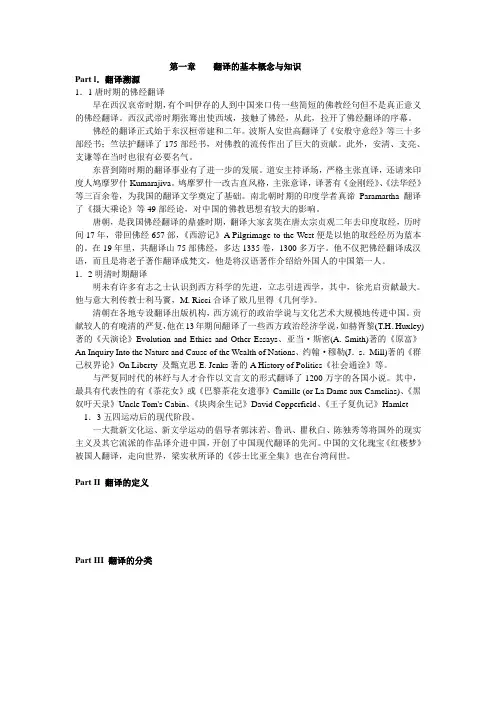
第一章翻译的基本概念与知识Part l.翻译溯源1.1唐时期的佛经翻译早在西汉哀帝时期,有个叫伊存的人到中国来口传一些简短的佛教经句但不是真正意义的佛经翻译。
西汉武帝时期张骞出使西域,接触了佛经,从此,拉开了佛经翻译的序幕。
佛经的翻译正式始于东汉桓帝建和二年。
波斯人安世高翻译了《安般守意经》等三十多部经书;竺法护翻译了175部经书,对佛教的流传作出了巨大的贡献。
此外,安清、支亮、支谦等在当时也很有必要名气。
东晋到隋时期的翻译事业有了进一步的发展。
道安主持译场,严格主张直译,还请来印度人鸠摩罗什Kumarajiva。
鸠摩罗什一改古直风格,主张意译,译著有《金刚经》、《法华经》等三百余卷,为我国的翻译文学奠定了基础。
南北朝时期的印度学者真谛Paramartha翻译了《摄大乘论》等49部经论,对中国的佛教思想有较大的影响。
唐朝,是我国佛经翻译的鼎盛时期,翻译大家玄奘在唐太宗贞观二年去印度取经,历时间17年,带回佛经657部,《西游记》A Pilgrimage to the West便是以他的取经经历为蓝本的。
在19年里,共翻译山75部佛经,多达1335卷,1300多万字。
他不仅把佛经翻译成汉语,而且是将老子著作翻译成梵文,他是将汉语著作介绍给外国人的中国第一人。
1.2明清时期翻译明未有许多有志之士认识到西方科学的先进,立志引进西学,其中,徐光启贡献最大。
他与意大利传教士利马竇,M. Ricci合译了欧几里得《几何学》。
清朝在各地专设翻译出版机构,西方流行的政治学说与文化艺术大规模地传进中国。
贡献较人的有晚清的严复,他在13年期间翻译了一些西方政治经济学说,如赫胥黎(T.H.Huxley)著的《天演论》Evolution and Ethics and Other Essays、亚当·斯密(A. Smith)著的《原富》An Inquiry Into the Nature and Cause of the Wealth of Nations、约翰·穆勒(J.s.Mill)著的《群己权界论》On Liberty 及甄克思E. Jenks著的A History of Politics《社会通诠》等。
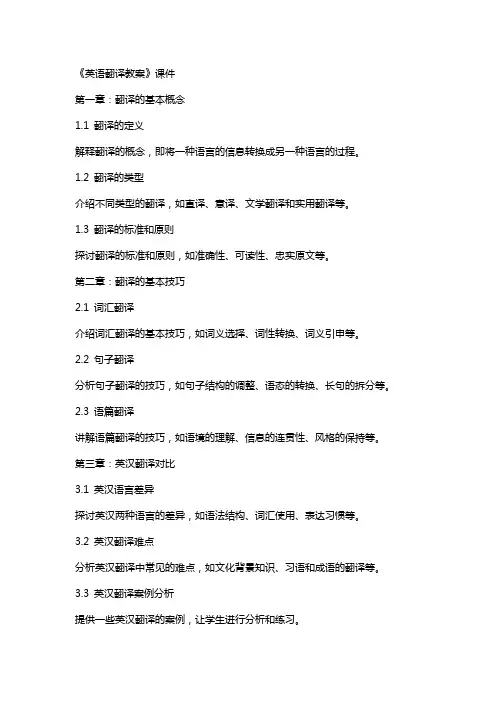
《英语翻译教案》课件第一章:翻译的基本概念1.1 翻译的定义解释翻译的概念,即将一种语言的信息转换成另一种语言的过程。
1.2 翻译的类型介绍不同类型的翻译,如直译、意译、文学翻译和实用翻译等。
1.3 翻译的标准和原则探讨翻译的标准和原则,如准确性、可读性、忠实原文等。
第二章:翻译的基本技巧2.1 词汇翻译介绍词汇翻译的基本技巧,如词义选择、词性转换、词义引申等。
2.2 句子翻译分析句子翻译的技巧,如句子结构的调整、语态的转换、长句的拆分等。
2.3 语篇翻译讲解语篇翻译的技巧,如语境的理解、信息的连贯性、风格的保持等。
第三章:英汉翻译对比3.1 英汉语言差异探讨英汉两种语言的差异,如语法结构、词汇使用、表达习惯等。
3.2 英汉翻译难点分析英汉翻译中常见的难点,如文化背景知识、习语和成语的翻译等。
3.3 英汉翻译案例分析提供一些英汉翻译的案例,让学生进行分析和练习。
第四章:翻译实践4.1 翻译练习设计一些翻译练习题,让学生进行实践操作,提高翻译能力。
4.2 翻译案例分析提供一些真实的翻译案例,让学生进行分析和讨论。
4.3 翻译评价和反馈对学生的翻译进行评价和反馈,指出其优点和不足之处,并进行指导。
第五章:翻译工具和资源5.1 翻译软件和工具介绍一些常用的翻译软件和工具,如谷歌翻译、有道词典等。
5.2 翻译资源和参考资料推荐一些翻译参考书籍、在线资源和翻译社群,供学生学习和交流。
5.3 翻译实践平台介绍一些翻译实践平台,如翻译公司、在线翻译平台等,供学生寻找实践机会。
第六章:专业翻译领域简介6.1 商务翻译介绍商务翻译的概念、特点和应用领域。
分析商务翻译中的常见问题和应对策略。
6.2 技术翻译探讨技术翻译的定义、要求和常见挑战。
举例说明技术翻译的实践案例和技巧。
6.3 法律翻译讲解法律翻译的基本原则和注意事项。
分析法律翻译中的专业术语和语言特点。
第七章:翻译与跨文化交际7.1 文化差异对翻译的影响探讨不同文化背景对翻译的影响和挑战。
翻译基本概念应知应会42个1、翻译科学(science of translating)由Nida在他的Toward a Science of Translating(1964)一书中最早提出, 他受乔姆斯基转换生成语法的影响, 采用语言科学的原则和方法, 以实证的态度来研究翻译过程, 忽略翻译工作中的非科学化的其他层面(例如艺术性、直觉等)。
20世纪60年代, 奈达曾是翻译科学的倡导者。
德国翻译界也长期主张把翻译研究工作称作翻译科学(Übersetzungswissenschaft)。
但德国学者的“翻译科学”具有跨学科性, 除主要为语言学之外还包括交际理论、文化研究等,代表人物和著作有Wolfram Wilss 的The Science of Translation: Problem and Method.(1977年德文本, 1982年英译本)。
2、翻译研究(translation studies)作为一门学科的名称、与英美习惯称为“翻译理论”、德语国家称为“翻译科学"同义。
英文对应词中的“研究”(studies)用复数, 暗示着种多元化的研究, 即翻译研究是门综合性、交叉性学科。
起先, 荷兰、比利时等低地国家把“翻译研究”作为学科名称, 由荷“阿姆斯特丹大学翻译教授霍尔姆斯(James Holmes ) 在The Name and Nature of Translation Studies (1972)一文中首先提出: 翻译研究应包括三个分支, 即: 1)负责描写现实世界里的翻译现象的“描写分支”; 2)负责确立可以解释这些现象的“理论分支”; 3)负责将从描写分支和理论分支中得到的知识应用于翻译实践和教学的“应用分支”。
Holmes试图用这术语来概括整个翻译学科。
Bassnett按照类似的思路将translation studies归为四大类: 翻译史、目的语取向的翻译、翻译与语言学、翻译与诗歌。
Some Basic Concepts of TranslationI.Some controversial issues:1.literal translation vs. free translation 直译还是意译2.functional equivalence vs. formal correspondence 功能对等还是形式对应3.content vs. form 重内容还是重形式4.source-oriented vs. target-oriented 靠近原语还是靠近译入语5.author-centered vs. reader-centered 以原作者为中心还是以译入语读者为中心6.the purpose of the author vs. the purpose of the translator 原作者写作的目的还是译者翻译的目的II.THE METHODS(Peter Newmark)1. Word-for-word translation (逐字翻译)This is often demonstrated as interlinear translation, with the TL immediately below the SL words. The SL word-order is preserved and the words translated singly by their most common meanings, out of context. Cultural words are translated literally. The main use of word-for-word translation is either to understand the mechanics of the source language or to construe a difficult text as a pre-translation process.2. Literal translation (直译)The SL grammatical constructions are converted to their nearest TL equivalents but the lexical words are again translated singly, out of context. As a pre-translation process, this indicates the problems to be solved.3. Faithful translation (忠实翻译)A faithful translation attempts to reproduce the precise contextual meaning of the original within the constraints of the TL grammatical structures. It …transfers‟cultural words and preserves the degree of grammatical and lexical …abnormality‟ (deviation from SL norms) in the translation. It attempts to be completely faithful to the intentions and the text-realisation of the SL writer.4. Semantic translation (语义翻译)Semantic translation differs from …faithful translation‟only in as far as it must take more account of the aesthetic value (that is, the beautiful and natural sound) of the SL text, compromising on …meaning‟where appropriate so that no assonance, word-play or repetition jars in the finished version. Further, it may translate less important cultural words by culturally neutral third or functional terms but not by cultural equivalents-une nonne repassant un corporal may become …a nun ironing a corporal cloth‟–and it may make other small concessions to the readership. The distinction between …faithful‟and …semantic‟translation is that the first is uncompromising and dogmatic, while the second is more flexible, admits the creative exception to 100% fidelity and allows for the translator‟s intuitive empathy with the original.5. Adaptation (改写)This is the …freest‟ form of translation. It is used mainly for plays (comedies) and poetry; the themes, characters, plots are usually preserved, the SL culture converted to the TL culture and the text rewritten. The deplorable practice of having a play or poem literally translated and then rewritten by an established dramatist or poet has produced many poor adaptations, but other adaptations have …rescued‟ period plays.6. Free translation (自由翻译)Free translation reproduces the mater without the manner, or the content without the form of the original. Usually it is a paraphrase much longer than the original, a so-called …intralingual translation‟, often prolix and pretentious, and not translation at all.7. Idiomatic translation (习语翻译)Idiomatic translation reproduces the …message‟of the original but tends to distort nuances of meaning by preferring colloquialisms and idioms where these do not exist in the original. (Authorities as diverse as Seleskovitch and Stuart Gilbert tend to this form of lively, …natural‟translation.8. Communicative translation (交流翻译)Communicative translation attempts to render the exact contextual meaning of the original in such a way that both content and language are readily acceptable and comprehensible to the readership.III.The nature of translating(Nida)“Translating consists in reproducing in the receptor language the closest natural equivalent of the source-language message, first in terms of meaning and secondly in terms of style.”1.Reproducing the messageTranslating must aim primarily at “reproducing the message”. To do anything else is essentially false to one‟s task as a translator. But to reproduce the message one must make a good many grammatical and lexical adjustments.2.Equivalence rather than identityThe translator must strive for equivalence rather than identity. In a sense, this is just another way of emphasizing the reproduction of the message rather than the conservation of the form of the utterance.3. A natural equivalentThe best translation does not sound like a translation. That is to say, it should studiously avoid “translationese”—formal fidelity, with resulting unfaithfulness to the contentand the impact of the message.4.The closest equivalentA conscientious translator will want the closest natural equivalent. It has been argued ,for example, that in present-day English a natural equivalent of “demon-possessed”would be “ mentally distressed.” This might be regarded by some as a natural equivalent, but it is certainly not the “closest equivalent”.5.The priority of meaningAs it has already been indicated in the definition of translating, meaning must be given priority, for it is the content of the message which is of prime importance for translating.This means that certain rather radical departures from the formal structure are not only legitimate but may even be highly desirable.6.The significance of styleThough style is secondary to content, it is nevertheless important. One should not translate poetry as though it were prose, nor expository material as though it were straight narrative. …It is usually quite impossible to represent some of the stylistic subtleties of the original.IV. Language Functions, Text-categories and Text-types(Peter Newmark)Three main functions:1.The expressive function (表达功能)The core of the expressive function is the mind of the speaker, the writer, the originator of the utterance. He uses the utterance to express his feelings irrespective of any response.The characteristic …expressive‟ text-types are:1)Serious imaginative literature: lyrical poetry, short stories, novels, plays.2)Authoritative statements: political speeches, documents etc; statutes and legaldocuments; scientific, philosophical and …academic‟ works written by acknowledgedauthorities.3)Autobiography, essays, personal correspondence.2.The informative function (信息功能)The core of informative function of language is external situation, the facts of a topic, reality outside language, including reported ideas or theories.Typical …informative‟ texts are concerned with any topic of knowledge, but texts about literary subjects, as they often express value-judgments, are apt to lean towards …expressiveness‟. The format of an informative text is often standard: a textbook, atechnical report, an article in a newspaper or a periodical, a scientific paper, a thesis, minutes or agenda of a meeting.3.The vocative function (呼唤功能)The core of the vocative function of language is the readership, the addressee. The term …vocative‟ is used in the sense of …calling upon‟ the readership to act, think or feel, in fact to …react‟ in the way intended by the text.We take notices, instructions, publicity, propaganda, persuasive writing and possibly popular fiction, whose purpose is to sell the book/entertain the reader, as the typical …vocative‟ text.However, few texts are purely expressive, informative or vocative: most include all three functions, with an emphasis on one of the three.V. Koller (1979) proposes a checklist for translationally relevant text analysis under the headings of:1. language fuction;2. content characteristics;3. language-stylistic characteristics;4. formal-aesthetic characteristics;6. pragmatic characteristisVI. Tytler’s three general ‘laws’ or ‘rules’ for translation(1797)1. The translation should give a complete transcript of the ideas of the original work.2. The style and manner of writing should be of the same character with that of theoriginal.3. The translation should have all the ease of the original composition.VII. Nida’s ‘four basic requirements of a translation’:1.making sense;2.conveying the spirit and manner of the original;3.having a natural and easy form of expression;4.producing a similar response.Naturalness is a key requirement for Nida.For Nida,the success of a translation depends above all on achieving equivalentresponse.Nida underlines that …correspondence in meaning must have priority overcorrespondence in style‟, if equivalent effect is to be achieved.IIX. Vinary and Darbelnet’s model(2000)The two strategies they identified (literal/free) comprise seven procedures, of which direct translation covers three:1.Borrowing: The SL word is transferred directly to the TL.2.Calque: This is a special kind of borrowing where the SL expression or structure istransferred in a literal translation. Eg. summit meeting <> 峰会3.Literal translation: This is a …word-for-word‟translation, which Vinary and Darbelnetdescribes as being most common between languages of the same family.4.Transposition: This is a change of one part of speech for another without changing thesense. Vinary and Darbelnet see transposition as the most “probably the most common structural change undertaken by translators”. They list at least ten categories, such as: verb to noun; adverb to verb ….5.Modulation: This changes the semantics and point of view of the SL. It can be:1)obligatory: e.g. “the time when”translates as “the moment where”in French (lemoment ou). “You‟ve had a narrow escape.”你真是死里逃生!2)optional: e.g. the reversal of point of view in “it is not difficult to show” translates as“显而易见”6.Equivalence: Vinary and Darbelnet use this term to refer to cases where languages describethe same situation by different stylistic or structural means. Equivalence is particularly useful in translating idioms and proverbs, e.g. as strong as a horse —> 壮如牛.7.Adaptation: This involves changing the cultural reference when a situation in the sourceculture does not exist in the target culture.IX. Polysystem TheoryA theory proposed by Even-Zohar to account for the behavior and evolution of literary SYSTEMS. The term denotes a stratified conglomerate (多层次的聚合) of interconnected elements, which changes and mutates (develop a new form) as these elements interact with each other.X. Other termsPragmatic translationA term used to refer to translation which pays attention not only to denotative meaning but also to “the way utterances are used in communicative situations and the way we interpret them in context.Receptor languageReceptor language is a term defined by Nida & Taber as “the language into which a message is translated from the source language.” It is basically synonymous with the term “target language.”Target languageTarget language is the standard term used to denote the language which is being translated into.Source languageSource language is the standard term describing the language in which the text being translated is written.InterpretingInterpreting is a term used to refer to the oral translation of a spoken message or text. Interpreting differs from translation in a number of important respects.1.The communication skills needed are clearly different. Interpreters need to be expert oralcommunicators.2.Interpreters are required to create a finished product in “real time” without the possibility ofgoing back and making revisions.3.Interpreters must ensure that any background knowledge which they are likely to need hasbeen acquired in advance.4.Interpreters are “performers” who are constantly making split-second decisions and takingcommunicative risks; consequently they typically experience higher stress levels while “on the job” than most translators.Relay interpretingRelay interpreting is a term used to refer to the practice of interpreting between two (usually less widely spoken) languages via a third.ShiftsThe term is originally defined by Catford as “departures from formal correspondence in the process of going from the SL to the TL” (1965:73). The shifts described by Catford are therefore purely linguistic, being grammatical or lexical in nature.Toury (1980, 1995) further developed the notion of shifts, distinguishing two varieties, the obligatory (e.g. linguistically motivated) and the non-obligatory (e.g. motivated by literary or cultural considerations); the extent to which a TT contains non-obligatory shifts will determine whether its INITIAL NORM is one of ACCEPYABILITY or ADEQUACY.CompensationCompensation is a term in general use for a number of decades, and defined by Hervey & Higgins as “the technique of making up for the translation loss of important ST features by approximating their effects in the TT through means other than those used in the ST” (1992:248).Corpora (singular Corpus)Corpora is a term traditionally used in translation studies to refer to relatively small–scale collections of texts, (parts of ) which are searched manually for examples of features which are of interest.CorrespondenceCorrespondence is a term used to refer to the relationship which exists between elements of SL and TL that are in some way considered to be counterparts of each other. Correspondence is usually presented as a somewhat weaker notion than the perhaps more frequently encountered concept of EQUIV ALENCE (Hermans 1991:157).。
翻译必考知识点总结翻译是沟通的桥梁,它不仅仅是简单的语言转换,更是文化、历史和思想的传递。
在当今世界,翻译已经成为必不可少的技能,因此翻译考试也成为很多人必须面临的挑战。
无论是英语专业考研、公共英语、雅思、托福考试,还是翻译资格考试等,翻译必考知识点都是考生需要重点关注的内容。
本文将从翻译的基本概念、翻译理论、翻译技巧以及常见考试题型等方面进行总结。
一、翻译的基本概念翻译是指将一种语言的表达形式转换成另一种语言的过程。
翻译的目的是为了使目标语言读者能够理解原文的意思。
翻译的基本原则包括忠实、通顺、准确、得体和自然等。
翻译的过程包括理解原文、转换原文、校对翻译、修改翻译等步骤。
翻译的难点在于语言之间的差异、文化的差异、习惯表达的差异等方面。
二、翻译的理论翻译理论包括了直译理论、意译理论、功能对等理论、文化转换理论等多种理论。
其中直译理论强调忠实于原文,意译理论强调传达原文的意思,功能对等理论强调传达目的语言读者的需求,文化转换理论强调在翻译过程中进行文化因素的转换。
这些理论都在不同层面上揭示了翻译的本质和特点。
三、翻译的技巧翻译的技巧包括了词汇翻译、语法翻译、惯用表达翻译等方面。
在词汇翻译中,考生需要注意词义的转换、词汇的搭配、词法的变换等问题。
在语法翻译中,考生需要注意句子结构的转换、语态的变换、时态的表达等方面。
在惯用表达翻译中,考生需要注意成语、习语、惯用语等的转换和运用。
此外,考生还需要注重上下文的理解和逻辑关系的表达等方面。
四、常见考试题型翻译考试的题型包括了汉译英、英译汉、改错、选词填空、写作等多种题型。
其中汉译英和英译汉是最常见的题型,要求考生具备较高的语言能力和翻译技巧。
改错题目要求考生对句子的语法、词汇进行鉴别和修改。
选词填空要求考生根据上下文选择合适的词语填写在空格处。
写作题目则要求考生根据所给的材料或者题目进行短文或长文的翻译,要求考生除了熟练掌握翻译技巧之外,还需要有一定的表达能力和逻辑思维能力。